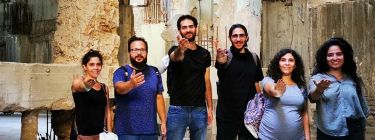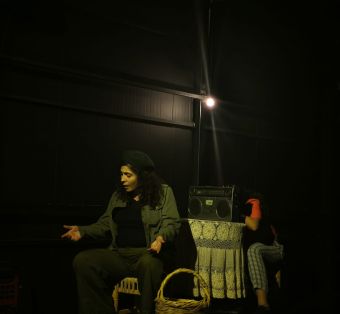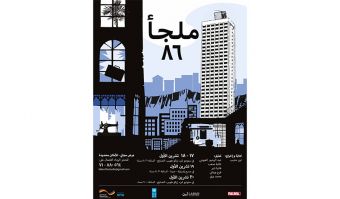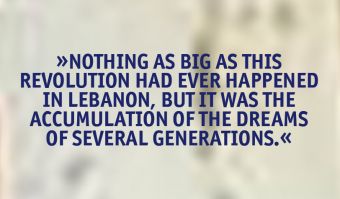
Is the show bigger than the art?
Director of theatre-based NGO Laban, Beirut

Is the show bigger than the art?
Producing Arts in times of revolution: Learnings from 30 years of Lebanon crisis about what artists might do and for whom in Renaissance
On 17 October 2019 in Beirut, Lebanon, I played the role of a dead fighter from the Lebanese civil war (13 April 1975- 13 October 1990). Twenty-nine years after the ceasefire in Lebanon, the civil war was still alive in the minds of the Lebanese. This open wound remains bleeding with thousands of missing, thousands of dead. The country proceeded with no reconciliation, no accountability, ruled by the same militia leaders and their customers until today. I call them customers as they are nowhere close to citizens: they live by and for the leader or political party, standing in the way of every possibility of change. Their relationship with the system is based on benefits to themselves, not rights and duties.
Picture above: Farah Wardani among several team members at the opera house that the people reclaimed during the revolution, Copyright: Laban
Picture left: Farah Wardani performing at one performance on the night of the revolution, Copyright: Laban
Malja’86 (Shelter’86) is a play based on stories of personal objects, all of which witnessed and survived the Lebanese civil war and were inherited by the subsequent generations. The objects are residues of a memory lost to the generation that experienced the war and the generations carrying the traumatic experiences of the past. This piece follows the story of Sami, who enters the memory of his grandmother, trying to look for his father. Inside her memory, he meets different characters from the past who might guide him—through their own memories and stories—to the truth about his father’s disappearance. On the opening night in Laban Studio, as I played Layla, the ex-fighter that lives in the memory of Sami’s grandmother, during a scene of a demonstration, I heard people chanting Thawra (revolution in Arabic). I felt immersed in the role; I had goosebumps all over my body. I felt a connection with my community, with this never-ending war, whose inherited trauma I hold in my psyche like every other Lebanese. After the show was over, I realised that thousands of people were marching the street right below our rooftop studio, on Spears Street, heading towards downtown Beirut, to announce the people’s revolution. I took a video on my phone and I knew this was the beginning of something huge.
Mlaja’86 opened that Thursday night and was expected to play until Sunday. However, the revolution took over the country and all activities were stopped to join the people on the ground. We, as Laban Studio, announced on our Facebook page, „In a matter of such national importance and duty, Laban is joining the civil protests in Martyr’s Square. Join us to raise our voice for the people and against the oppression. See you there!“
That was the right place for Laban and me as the director of this organisation.
On the streets, a woman approached my colleagues and me after we entered the Opera House of Beirut. The Opera House had been closed since the civil war. It was still closed as the same warlords wanted to demolish it and transform it into a hotel, or a personal business, erasing our culture as they did with several other cultural monuments. The revolting people took over several sites closed since the civil war in the heart of Beirut. The woman came and said, „You are the playback people. I thank you for this,“ with a hand gesture that contained the entire city, the country, the revolution.
We stood in awe and humbleness. ”Us? Why?“ my colleague asked.
She responded, „Your theatre taught us that we have a story worth sharing, we have a voice that we must use, and here we are writing our story, raising our voice, thank you!“ and she moved away on her bike. Yes, her bike. Quite unusual for Beirut. Here people only move in cars and buses. The city isn’t bike-friendly, it isn’t walking-friendly, it’s barely human-friendly. For a European reader, a bike in a public space is typical, if not the norm. No wonder that as we ask for fundamental human rights—Europe is on a carbon-free EU revolution.
The question here was, how do we do arts in the middle of all the beauty on the streets? Our safe space that was the closest thing to a public space, to a community that a Lebanese would dream of, was now too small in comparison to the streets and squares of the country, filled with citizens taking over the abandoned spaces and declaring them public, cultural, and collective.
Picture right: Poster for Malja’86 (Shelter 86) play, Copyright: Laban

The revolution produced street art, social and political art, graffiti, songs, dancing circles, and discussions. Movies were made and spread across the world from mobile phones, and every chant was a masterpiece, every slash on a wall was a mural, every conversation was an improvised piece of art. What do we have to offer meanwhile? My team of 25 young people, Laban, is a theatre-based organisation, working since 2009 in Lebanon to create safe spaces of expression. After hours and hours of discussions, the team members met and decided that no art can contain the moment and taking our art forms into the street is a selfish act: Our work will be climbing over the revolution’s shoulders and will add nothing to it.
We decided to join our people. We took to the streets for months, experienced tear gas, rubber bullets, were assaulted by police thugs, got arrested, protested, shouted, chanted, danced, talked, and put our hearts, bodies, and intellect into this revolution as we do with our art. It was a collective masterpiece in the making. Meanwhile, the conversation didn’t stop: What do we do with our art? We are artists, and this is what we do for a living, to provide for our families, to survive.
„The one who opens something knows well how to contain it.” This wisdom came from a friend of the organisation. Let us perform our art to contain the individuals, not the community. In our playback, we always take the story shared by an individual, an audience member, to the communal level. We tackle the political in personal stories. Now we switched the game, now is the time to tackle the personal in all this political happening.
We had our first monthly performance around four weeks after the revolution started. People came in, a lot less than usual. The streets had all the eyes and light on them. We had our space opened for those who wanted to go small in the middle of the big act. Four weeks and violence was already happening, hidden agendas were surfacing, and the rhetoric of treachery was all over the mainstream media. The stories that emerged were, directly and indirectly, reflecting the fear of the people: how Lebanese people saw a glimpse of hope, an unusual hope. And now they were afraid of believing and losing, they weren’t ready for another grief, another loss, they weren’t prepared to be put down, again and again. Nothing as big as this revolution had ever happened in Lebanon, but it was the accumulation of the

dreams of several generations. The stories were communal and political, but we focused on the personal. We listened profoundly and touched on the sharing’s most resounding note, and it was reflected on stage. Our stage served as a margin to the revolution.
Our art form is minimal and intimate. For several nights, I wished we did drum circles, street art, dabkeh dance, or any art form that could be transformed into jam sessions and that the masses could join in immediately so that we could go on the streets and engage with the people. I saw other artists taking their music, clowning, and dancing into the streets but what was happening was bigger than any framed artwork, from any rehearsed acts.
I was six months pregnant with my second child, and my first was four years old. We were on the street of Al Azariyeh, where six clowns were jumping and connecting with the people. A finance expert had some people gathered around him talking about the financial crisis.My son had his eyes all on the finance expert, totally ignoring the clowns, and when the man finished his explanation, my son started clapping hard. Unintentionally, the man had put on a show, he had stolen the spotlight from the clowns and everyone else. He had the charisma, the presence, the passion, and the devotion—all the factors you need to grab the attention of the young and the old. The clowns proved the theory that when the show is bigger than your art, you should make way for things to happen at their own pace. Your time will come.
Farah Wardani
Farah Wardani is a theatre actress, trainer, clown doctor, puppeteer and applied theatre practitioner.A theatre graduate with a DipHE, a BA in psychology, currently finishing her MA in Drama Therapy.
Farah is the director of Laban (a Lebanese theatre based NGO). A Playback Theatre practitioner, trainer, actress, conductor and faculty member of the ASPT, she leads drama therapy workshops with Intisar Foundation targeting Arab women victim of war.
Farah trains and uses Theatre of the Oppressed, Drama Therapy and other techniques with different communities and contexts as a medium for healing, social change and political activism.
Picture © Mohsen Al Zaher for Laban
